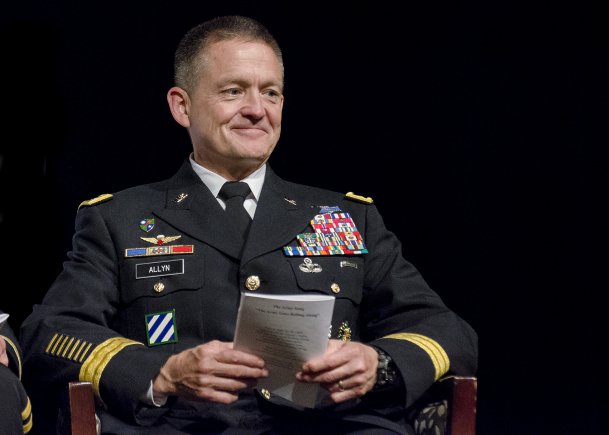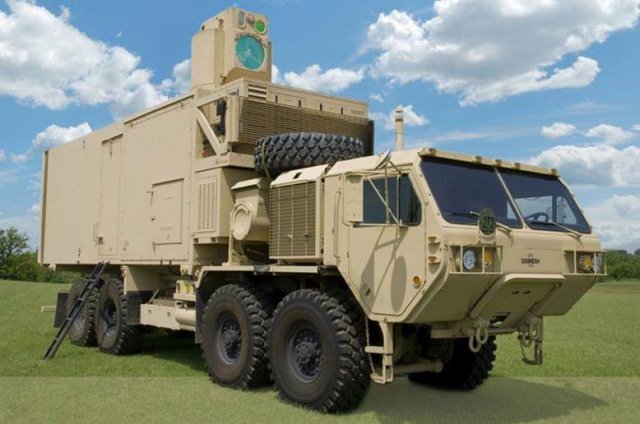Army Wants To Buy Back Guard Apaches In 2018: VCSA Allyn
Posted on

Gen. Daniel Allyn
WASHINGTON: Army budgeteers are laboring mightily to fund four National Guard attack helicopter battalions in their 2018 request, if Congress doesn’t add the money for 2017, the service’s vice-chief said today. The Army also has “a resourcing strategy” to restore an 11th Combat Aviation Brigade — a mix of attack and utility helicopters — to be permanently based in South Korea, Gen. Daniel Allyn said this morning at the Heritage Foundation.
“The Army’s committed to finding ways to resource the recommendations the commission has made” — the National Commission on the Future of the Army — “the vast majority of them,” Allyn told me after his public remarks. “We are working very had to deliver on…many of the recommendations that the commission brought forward.” Including those two? “Including those two.”
[UPDATE: The AH-64 Apache gunship is often on the cutting edge of US forces, with the Pentagon acknowledging Tuesday morning that it had used them June 12th against the Islamic State in Iraq].
Both the four AH-64 Apache battalions and the multi-aircraft brigade were cut under earlier Army downsizing plans. The National Guard community erupted over what would have been the loss of all its gunships, however, and Congress created the commission to resolve the matter. The commission’s 63 recommendations included restoring both the four Guard battalions (two others still go away) and the active-duty brigade.
Army leadership reacted positively but cautiously to the commission, saying they liked most of its ideas but couldn’t afford all of them. The service’s budget requests for 2017 came out before the commission’s recommendations, so it naturally didn’t include any: To the contrary, it cut aviation steeply. The service’s Unfunded Requirements list did ask Congress for the necessary funds, but whether any of that money materializes is, as always with such wishlists, very much up in the air.
Allyn’s remarks this morning still don’t constitute a commitment to funding the four Guard Apache battalions or the Korea-based brigade, but they come closer than I’ve ever heard from such a senior officer.
That said, even the Vice-Chief doesn’t have authority to make promises about a budget still in draft — only the White House does. The budget under development is just that, under development,” he told me, “and whether or not our priorities prevail remain to be seen.”
Allyn also emphasized how painful are the tradeoffs the Army faces.
“The national commission brought forward a great endstate — a better future Army — and a number of ways to get there, but it was not provided means,” he told the Heritage audience. “A strategy has to put all three together.”
Readiness is Chief of Staff Mark Milley’s top priority, and the Army’s made major strides since 2013, when sequestration cuts slashed training and maintenance while units were still recovering from Iraq and Afghanistan. Allyn pledged further work on National Guard readiness in particular: Guard combat brigades will get more turns in the service’s high-end Combat Training Centers, and Guard units deemed most likely to deploy will get more training than the baseline 39 days a year (one weekend a month and two weeks a year).
“I’m comfortable with the trend lines we’re on in terms of achieving our readiness goals,” said Allyn. “I am less comfortable with where we’re at in terms of modernization.”

Army HEL (High Energy Laser) Mobile Demonstrator
Modernization Priorities
About fifty percent of the Army budget goes to compensate soldiers, said Allyn, 10 percent to Army civilians, 22 percent to readiness, and just 18 percent to modernization, the development and production of new equipment. While the service has protected long-term research, it has few new weapons entering service in the near term.
Between limited funds and the rapid pace of modern technology, the Army seems to have given up on issuing every unit each new piece of kit. At realistic funding levels, it took decades to update the entire Army, by which point the last units in line were being issued “new” equipment that was already obsolete. The new model is to issue new tech to a small number of priority units over a short span of time, after which you grab the next iteration of technology and issue that to the next slice of the Army.
“We have begun to look at how do we prioritize delivery of capability to a smaller number of units, rather than spread the peanut butter over 35 years,” Allyn said.
What specifically does the Army prioritize in these tight budgetary times? Allyn listed three for the near term:
- self-defense systems (“active protection“) to let armored vehicles and aircraft shoot down or jam incoming missiles;
- the Improved Turbine Engine Program to upgrade existing Army helicopters (and, eventually, the Future Vertical Lift program to replace them); and
- cybersecurity. “We’ve got critical needs in addressing cyber vulnerabilities across our network,” he said.
In this cash-strapped context, the Pentagon’s “Third Offset Strategy” for artificial intelligence and military robotics seems far away and unaffordable. But Allyn insisted the offset, driven by Deputy Secretary of Defense Bob Work, remains relevant to the Army.
“We’re thankful DepSecDef is pursuing the third offset approach because it does enable a focus on what we need 15-20 years down the road,” said Allyn. (Not said aloud: the Army is too stressed right now to spend much time looking that far ahead).
What does the Army want specifically out of the offset strategy and William Roper’s Strategic Capabilities Office for near-term high-tech. “We know particularly in the area of integrated air defense” — i.e. shooting down incoming aircraft and missiles — “and long-range precision fires” — i.e. shooting missiles of our own at distant targets — “that there are very, very specific capabilities that hold promise that we are working very carefully with Dr. Roper and his team,” Allyn said.
But everything remains limited by the budget, Allyn said: “You can’t have it all. That’s just a raw fact.”
Subscribe to our newsletter
Promotions, new products and sales. Directly to your inbox.
